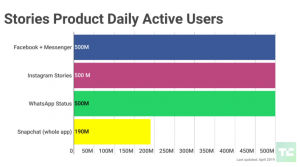4. 31% of Millennial and 39% of Gen Z users create Instagram content.
The percentage of Instagram users that create content on this social media network is much lower compared to those who consume the network’s content. So we have 31% as content creators among Millennials and 39% among Gen Z. In contrast, these two generations are much more active in consuming Instagram content, with 70% of Gen Z users and 58% of Millennials defining themselves as content consumers.
Now, let’s see if there are any differences in how Instagrammers use Instagram Stories.
(Source: VidMob)
5. 86.6% of Instagrammers post on Instagram Stories.
Not only do Instagram Stories stats like this illustrate a high adoption rate of the Stories format, but it also shows that Instagrammers are quite active in creating Instagram Stories. So while we had roughly one-third of content creators among younger populations on IG, Insta Stories is an exception. Almost everyone uses Instagram’s Stories format.
However, only 36.6% of Instagrammers prefer watching Stories, with 63.4% of users favoring Insta posts. Still, nearly all users post on IG Stories. Considering that one-third of IG users are content creators, content creation trends are clearly more impressive with Stories since 86.6% of its users create content.
(Source: The Preview App)
6. 60% of Millennials watch and post IG Stories.
Instagram Stories stats show that Millennials favor Instagram Stories over other social media Stories formats. According to VidMob’s 2018 “State of Social Video” report, 60% of Millennials use Insta Stories. A somewhat lower percentage of Millennials use Stories on Snapchat (53%). And Facebook ranks third, with 48% of Millennials using the network’s Stories feature.
(Source: VidMob)
7. 59% of Millennials and 70% of Gen Z users watch IG Stories.
It has the largest viewership among Millennials (59%), Instagram Stories usage stats show. However, Snapchat performs slightly better with Gen Z users when it comes to watching Stories. 72% of users from this age group watch Stories on Snapchat, compared to 70% doing so on Instagram.
(Source: VidMob)
8. 61% of Instagrammers use Stories to see what their friends are doing.
A study from Facebook revealed the top three reasons Instagrammers watch Stories. According to stats, the highest percentage of users, at 61%, checks IG Stories to see what their friends are currently doing. 58% of Instagrammers watch Stories to see unedited/authentic content, while the third most common reason behind watching Insta Stories, at 55%, is finding the funny content selected by users.
(Source: Facebook)
9. 1 in 4 Millennials and Gen Z-ers look for Stories of the products or services they want to buy.
IG Stories isn’t just a way to connect with friends and family or find humorous content. Instagram Stories statistics show that the format is also useful for helping Instagrammers make purchasing decisions. A VidMob study showed that 25% of Millennials and Gen Z users browse IG Stories for the products and services they’re considering buying. This stat shows that Instagram Stories is a powerful selling tool that helps businesses do more than just increase their visibility on social media.
(Source: VidMob)
10. 51% of brands are using Video in Instagram stories and it has better retention.
Half of the brands are using video in stories and it is outperforming stories with images by having a tap-forward rate with 5.65% lower. Also, people drop off more on photos than videos.
(Source: Socialinsider)
11. 15–25% of people swipe up on the links in branded Stories.
Stories offers the convenient option of simply swiping up on an Insta Stories link to visit a site. These Instagram swipe-up ads have been warmly welcomed by Instagram users. The following average swipe-through rates come from different brands that have successfully used this feature.
The clothing brand MeUndies saw 15% to 20% of all visitors to their site coming from the link they’d added to their Instagram Story. Outside magazine recorded an even higher swipe-through rate, with 20% to 25% of Instagrammers following the Stories link to visit the magazine’s website.
These findings are, however, from 2016. We can assume that the swipe-up feature today offers different Instagram Stories stats, with the 2019 swipe-through rates most likely being significantly higher.
(Source: Marketing Land)

